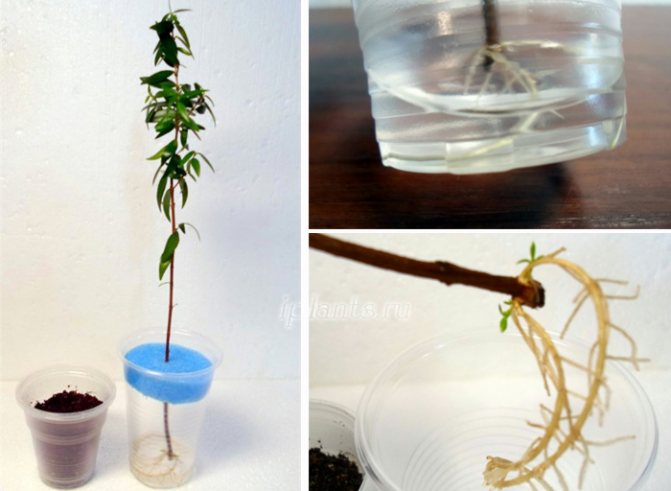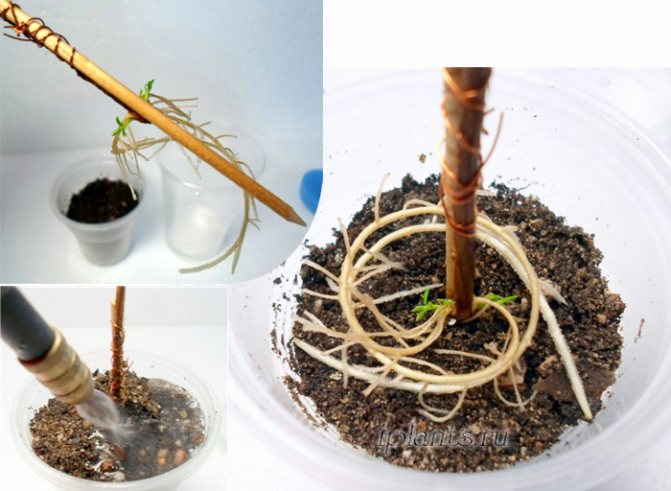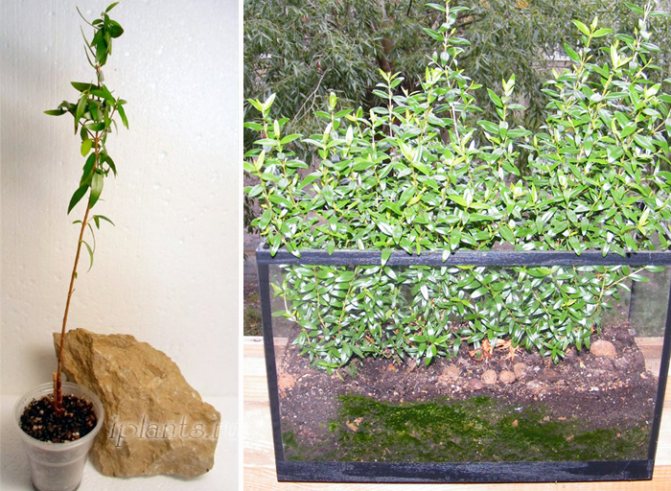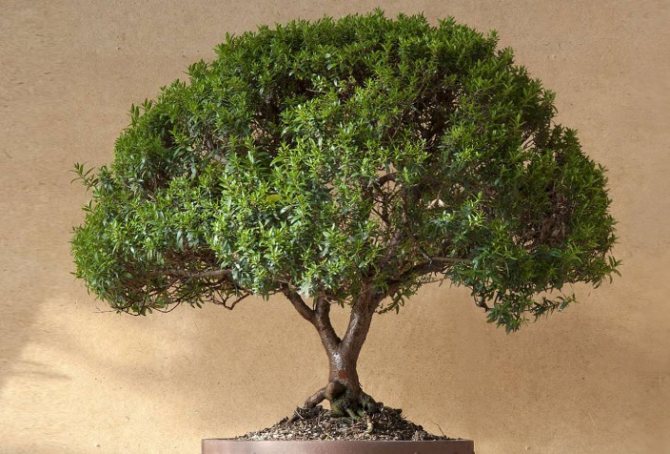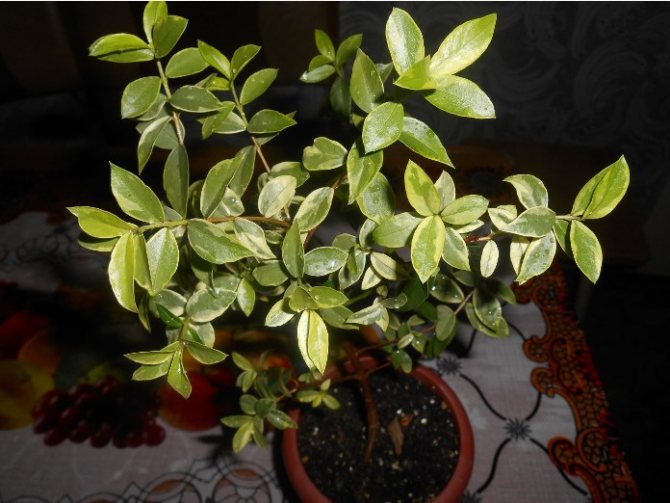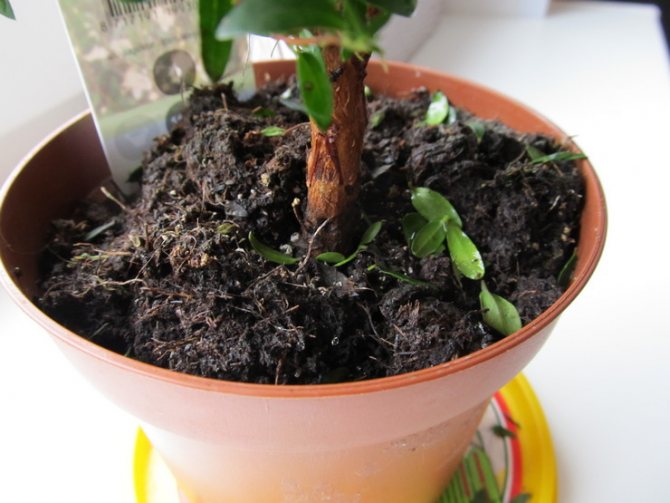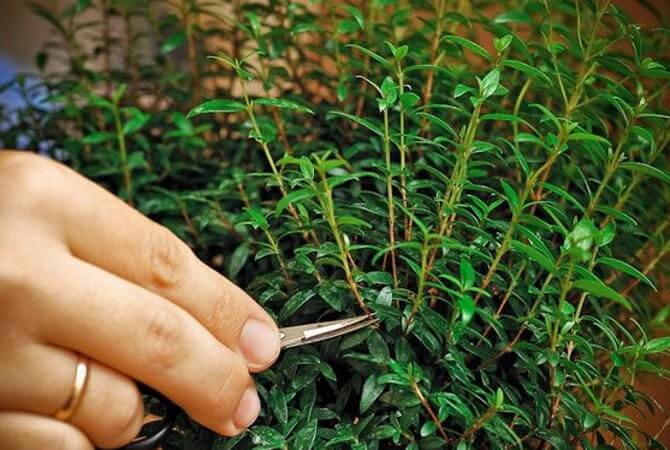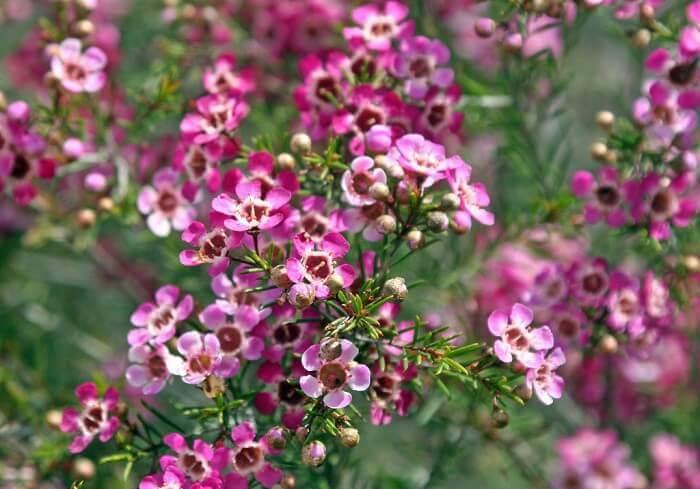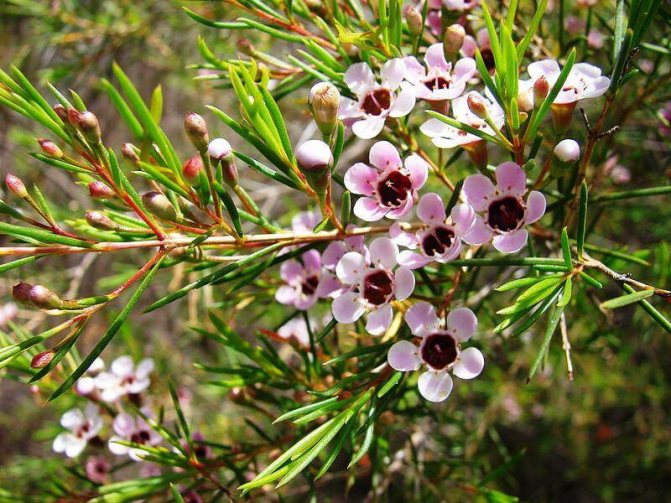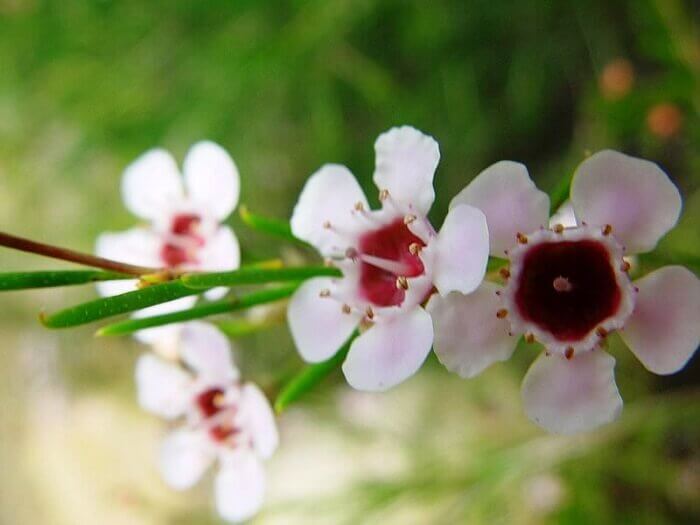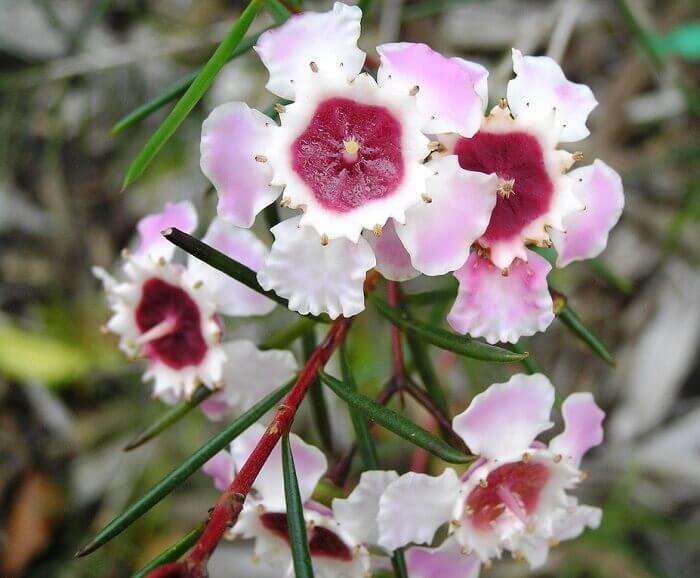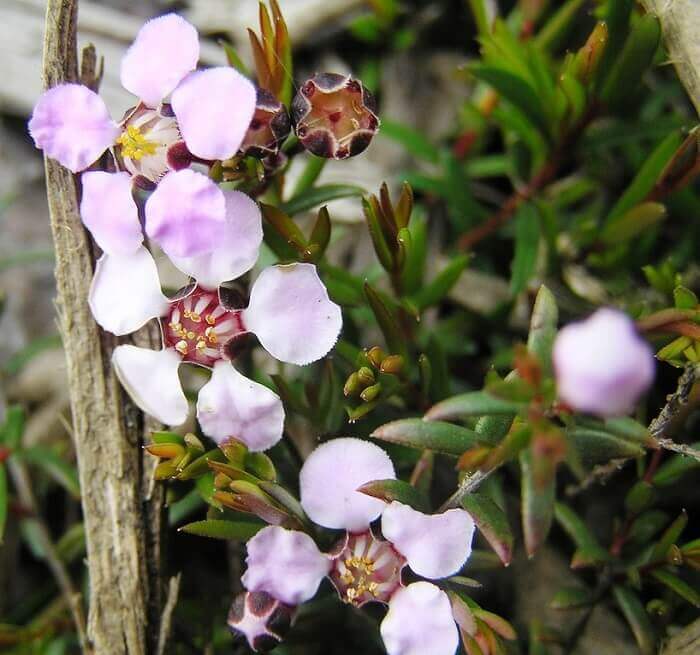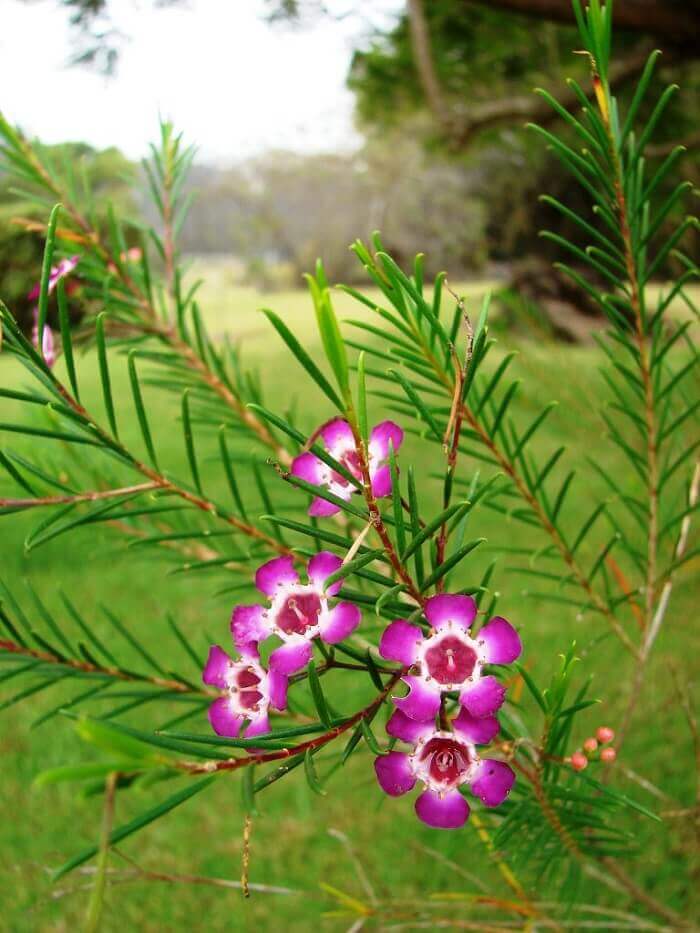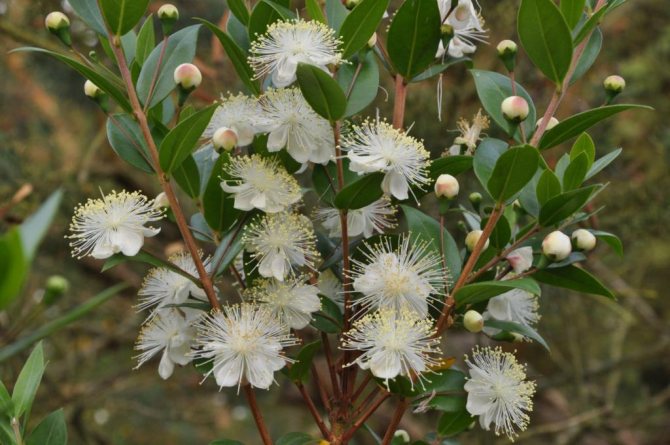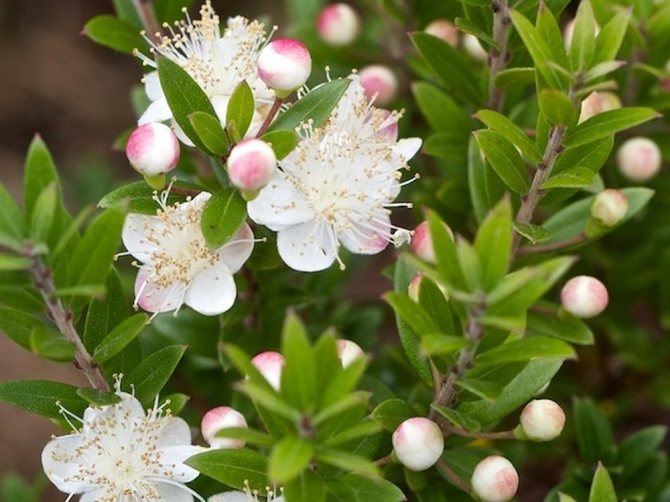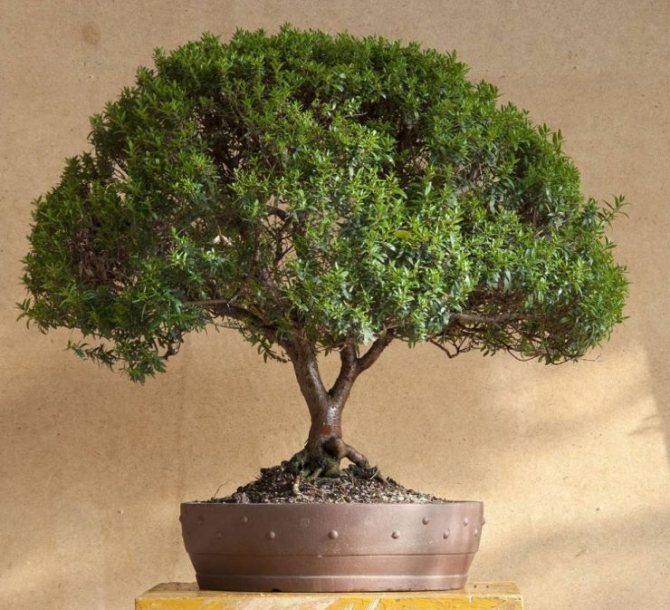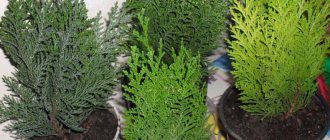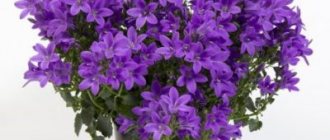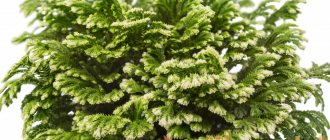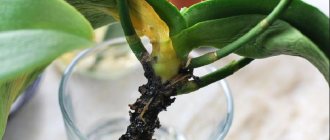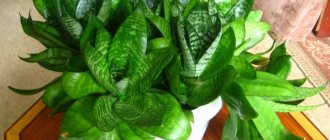Wax myrtle (in other words, this plant is also called chamelacium, flowering spruce, gristle) is a rather unusual, atypical plant that has rather bright decorative characteristics. The twigs are covered with very narrow foliage, which more closely resembles needles than the usual plant with typical leaves. The flowers, on the other hand, are more reminiscent of apple blossom, in combination with the deciduous part, they look quite original, and they look very delicate. Most likely, it is due to this that wax myrtle is so popular. When a plant is in the flowering stage, it will certainly be able to win the hearts of absolutely any flower growers, even those who, in principle, already have experience in growing a wide variety of crops and plants and, it would seem, it is not easy to surprise them at all. In addition, wax myrtle is very easy and simple to care for, but the result is incredibly attractive - it delivers true aesthetic pleasure.
Origin and appearance
The genus Myrtus includes about 110 species of shrubs or small trees. Small forms of Myrtus communis have proven their value when grown as domestic crops.

Blooming myrtle
In combination with other indoor plants, the tree looks very organic. It is noticed that it can have a calming effect on the nervous system. In various parts of the world, since ancient times, the plant has embodied love, peace, harmony, beauty and youth. The presence of myrtle in the wedding room among European nations creates a special aura and is a sign of a successful marriage and family happiness.
The natural habitat of the evergreen myrtle tree is the subtropical regions of the Mediterranean, other species grow in Australia, Asia, America. In its homeland, myrtle reaches a height of 5 m, if grown indoors, then it rarely exceeds 60 cm. The main external signs of a plant:
- leaves are small, glossy and dense, ovoid, slightly pointed;
- flowers are white and pinkish, in their composition, as in the leaves, a high content of essential oils;
- fruits - berries of dark blue color, there are also other colors.
The originality of the plant, the ability to decorate any interior attracts florists. In addition to external expressiveness, myrtle has the following advantages:
- essential oils contain volatile substances that have antimicrobial, antibacterial effect, allergy symptoms may decrease or disappear from their healing effect;
- decoctions and infusions for skin care can be made from leaves and flowers;
- dried berries and leaves will serve as a spice in cooking.
Interesting. In Greek mythology, myrtle is the protector of lovers. Goddesses and common women adorned themselves with flowering myrtle branches. A similar custom existed among other peoples. Young Jewish women during the Babylonian captivity wore myrtle wreaths as a sign of love and as a sign of marriage.
History of appearance
Under natural conditions, the flower grows in Mediterranean countries with a subtropical climate. It is an evergreen shrub or tree that grows up to two to three meters. In nature, there are many varieties growing in America, Australia, and Asian countries.
It is decorated with small bright green leaves located opposite each other on the branches. Small leaves on short cuttings are pointed towards the ends. Flowers of white, pink color grow in clusters in clusters or singly. There are types of myrtle with simple or double flowers, with a different number of petals. After flowering, fruits appear on the plant - drupe-like berries.
Myrtle is valued among flower growers not only for the appearance and aroma of flowers. Its main advantage is the presence of phytoncides and essential oils in leaves, flowers and fruits. They purify the air in rooms, which leads to a decrease in colds and an increase in efficiency, stress relief. Therefore, the myrtle tree can be found in office buildings.
An infusion made from leaves and flowers is used to cleanse the face. In some countries, the leaves and fruits of myrtle are used as a seasoning for dishes.
We invite you to familiarize yourself with: Vacuum cleaner for upholstered furniture and carpets: which vacuum cleaner is better for cleaning carpets and fabrics?
Types and varieties
Peperomia Lilian Caperata - home care
Of the existing varieties, the common myrtle, or Myrtus communis, is the most commonly used houseplant. It is characterized by compact shape, fast growth, high decorative effect. The trunk of the tree is covered with bark in the form of scales, which can flake off. Leaves are oval, dense, glossy. White flowers have a large number of long stamens.


Myrtus communis
Breeders have developed several hybrid varieties. The most popular ones are:
- Tarentine. A dwarf variety of common myrtle. The elongated leaves are limited in size to 1.5 centimeters. Blooms in groups of small flowers. Differs in accelerated growth;


Myrtle of Tarentine
- Alhambra. The plant has small, dense leaves with a lot of essential oils. Numerous flowers have a slightly pinkish tint at the beginning of flowering. The fruits are white in color;
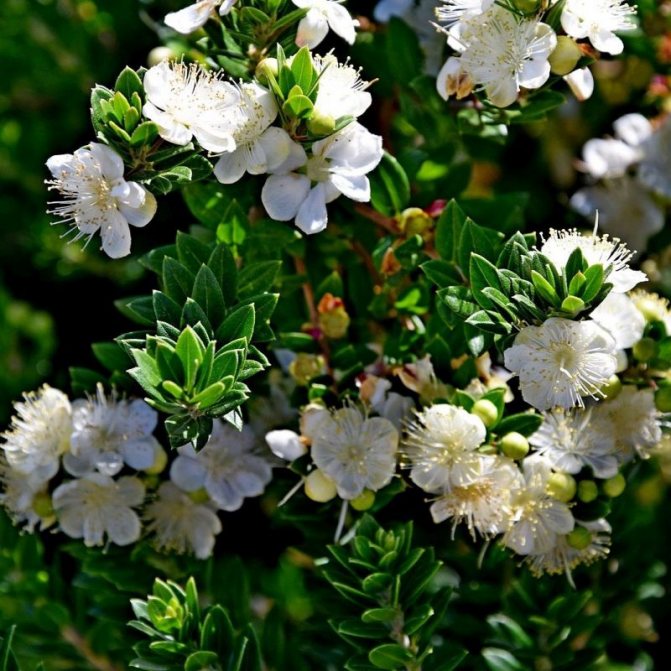

Myrtle Alhambra
- Variegata, with unusual color of leaves. Their main color is dark green. There is a gold border along the edge, light spots are possible in other places of the leaves;


Myrtle Variegata
- La Clape. Differs in purple fruits;
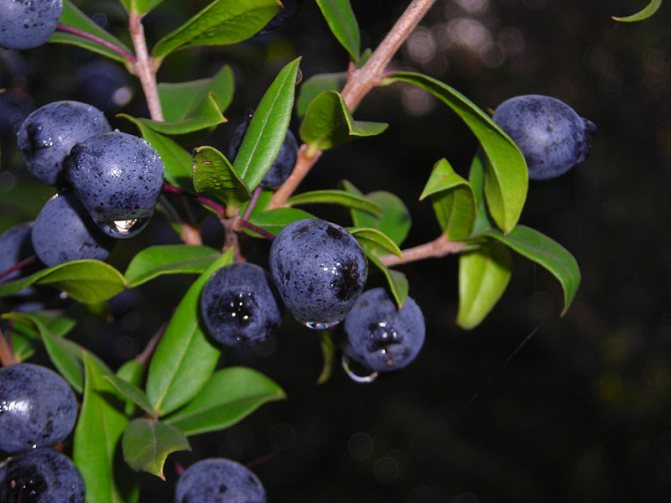

Myrtle La Clape
- Microphylla. Possesses compact forms, the height does not exceed 60 cm. Small-leaved variety with a dense crown. Young leaves are bright, darken with age.


Myrtle Microphylla
Types of wax myrtle
The chamelacium (wax myrtle) genus includes about 14 plant species, as well as several bred hybrid varieties that are also popular in floriculture and horticulture. Almost all species and varieties are cultivated, but at the same time if we go to flower or garden shops, then we can meet only a few basic species.
Chamelacium hooked - this species is most common in horticulture today. This bush is distinguished by its spreading and very attractive crown. Every year it can be noted that it increases in size, the height of the bush sometimes reaches two meters. In this case, it is possible to carry out formative pruning of the shrub, since it tolerates it almost painlessly. On young shoots, very young and very bright, attractive leaves in the form of needles are very densely located. Old branches can be exposed, so sometimes gardeners simply remove them by pruning. At the very beginning of spring, the very first inflorescences appear, sometimes they can be located in the racemes, but mostly they are single flowers. Depending on what kind of plant, flowers can be of different shades - there are white and pink, purple and violet, bright red or romantic lilac colors. Also, the flowers may not be ordinary smooth, but also double, which makes the bush even more decorative and attractive.
Chamelatsium Matilda - a shrub that is compact and grows very dense, almost impenetrable crown. In the southern regions, this species can be grown without much hassle in the open field, since the plant can withstand sudden temperature changes, severe frosts, and calmly react to drought and heat. The flowering of the variety is very abundant, when the flowers are just opening, then the flowers are snow-white in color with a very thin scarlet edging, which looks very delicate and cute. For all the time that the flowers bloom, they gradually turn into darker, purple or pomegranate shades, which is why this species attracts landscape designers from all over the world.
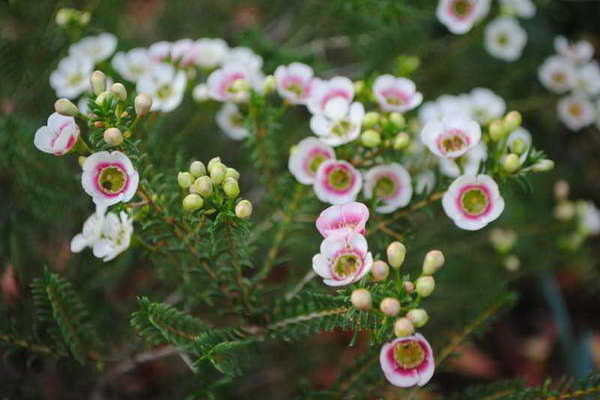

Chamelcium Darwinia - the maximum height of the bush is about half a meter. It is ideal for creating bonsai trees. At the same time, elongated leaves of a dark green, very juicy shade appear on the bushes. The flowering is incredibly beautiful - the flowers are bell-shaped, they are painted either in snow-white or in a light pink shade, the middle of the flowers is painted in bright yellow, canary or burgundy colors. This kind of contrast looks incredibly appealing for these types of landings, so it's worth keeping in mind.
Chamelacium ciliatum - flowers on the shrub grow not only very beautiful, but also very large in size. They can almost completely cover the shrub of wax myrtle, which, of course, causes genuine delight and interest in any gardener or garden guest. Due to the fact that the plant tolerates pruning quite calmly, you can create absolutely any shape of it. You can also make the bush very compact, and even a bonsai tree, which is very popular today, will also form. However, the choice of species and variety depends entirely on what the gardener is striving for, and what result he wants to achieve in planting.


Pot transplant
Stromanta - home care and reproduction
The plant is considered quite capricious, intolerant of stress, travel, temperature extremes. To prevent the tree from dying when the living conditions change, it is necessary to follow four rules for caring for myrtle:
- Do not replant immediately after purchase. It is necessary to wait for the plant to adapt. A quick transplant often leads to the fact that the leaves begin to fall off, and the myrtle perishes;
- Increase humidity. If the tree looks weak, the leaves are sluggish, some stems are bare, you can cover it with a transparent plastic bag, creating a greenhouse effect. The package is removed for a short period of time every day. In greenhouse conditions, myrtle lasts up to 1 month;
- Keep in partial shade. For the period of adaptation, the myrtle is placed in partial shade, protected from direct sunlight;
- Avoid drafts. Even a healthy adult bush reacts negatively to drafts; in the case of a newly acquired young plant, this is unacceptable.
Important! It is best not to touch the myrtle for two weeks after purchase. The indications for transplanting are a small vessel, an unimportant tree condition or poor soil composition. In other cases, it is better to postpone the transplant until the spring.
What is needed for landing
Until the age of three, myrtle is transplanted annually, each time slightly increasing the volume of the flower container. Adults only need one transplant every 3-4 years.
Features:
- The soil should be loose, light, moderately nutritious. A versatile flower potting soil mix with chopped peat and coarse sand is suitable;
- The size of the pot is chosen slightly larger than the root system, the shape is similar to the previous container in terms of the ratio of width and height. It is checked that drainage holes are visible at the bottom;
- As a drainage, it is necessary to prepare small pebbles, brick or ceramic chips.
Optimal location
In the post-transplant period, the myrtle should be placed in a relatively shaded and cool place. However, when the plant has already adapted, it can be moved to a permanent location, the choice of which should be approached taking into account the following recommendations:
- The myrtle tree loves well-lit surfaces, but does not tolerate heat well, so it is desirable that diffused sunlight falls on it.
- The plant does not like a sharp change in habitat, it must be moved gradually.
- The southwestern and southeastern sides of a house or apartment are optimal places for a tree to live, since in the north the plant rest period is lengthened, its growth is inhibited, flowering may not occur.
Landing procedure
The step-by-step procedure for planting myrtle includes the following steps:
- Prepare everything you need: soil, pot, drainage, after sterilizing them;
- Achieve drying of the soil. The plant should be slightly dehydrated before transplanting. So it can be pulled out of the previous container without any problems;
- Create a drainage layer in a new pot, it should be a third of the volume, fill half the pot with soil;
- Cleansing an earthen coma with roots. It is convenient to gently straighten the roots with a wooden stick. Cleansing is carried out only at the edges;


Myrtle transplant
- Root processing. If there are dry or rotten roots, they are removed by treating the sections with coal dust and Kornevin;
- Gently place the bush in the middle of the pot with soil, sprinkle the roots, gently pressing with your fingers.
Important! The trunk should not be covered with soil - this can lead to rotting.
For early adaptation to the new pot, the tree is immediately watered and sprayed. Then it remains in partial shade for about a week with regular spraying. Irrigation with a solution of a weak growth stimulator "Epin" will be useful. When new shoots appear, the myrtle is moved to a permanent habitat.
Crown formation
The formation of the myrtle tree is ongoing. Trimming the ends of the shoots can be carried out repeatedly during the spring-summer season. You can grow a myrtle tree in a completely free style, with a shaggy bush. You can form a stem or other style. But first you need to present the image you want to strive for.
A myrtle tree blooming with pink buds (on the right in the photo, Pavel Karpenkov) is so beautiful not because of its extreme unpretentiousness, but because it is grown in ideal conditions for it: it stands in an area where the illumination is close to sunny, the humidity is 90% and the temperature is 24 ° C. It is watered once every 2-3 days (it does not dry out and is not poured).
Important: when wintering in cool and, even more so, cold conditions, spraying is not required, and watering is scarce.
With the help of a wire, you can pull the branches in the right direction, they are quite plastic even in adulthood. But old branches covered with brown bark can be bent gradually, smoothly, over several months.
Pay attention, while the myrtle tree is gaining trunk thickness, it does not need to be planted in a bonsai pot, the pot space is needed for the plant to accelerate the trunk.
From personal experience, Borya: My myrtle grows on the northwest window, but I cannot form a spherical crown without additional lighting. I use this technique: as the branches lengthen, I tilt the largest of them to the sides almost to a horizontal position, and secure with wire. Then, along the entire length of the branch, new shoots begin to appear from dormant buds (before they were in the shade), and the entire branch turns out to be densely leafy.
The size of the pot should correspond to the size of the root system and grow as the earthen coma is woven. It all depends on how many roots the myrtle has. In my opinion, it is better to take a cramped dish than a spacious one, since in the second case, part of the earth can sour and become unusable even before the roots have time to penetrate it.
I prefer to plant myrtles in a mixture of some kind of peaty soil with coarse sand, in a 1: 1 ratio. From the purchased, you can, in my opinion, use the 'Cactus' mixture, as the most porous and suitable for most plants.
From personal experience, Borya: You need to choose the largest, central, and, most importantly, the branch of the bush that you like most and cut off all the rest. It is convenient to do this with small nail clippers. On it, you need to remove the leaves and side shoots from below to the height of the proposed trunk. This will create an even trunk that will slowly grow fat.
Since during the growth of a 'bush' the branches touch and, as it were, a little 'propping up' each other, then, being left alone, this twig may bend for any reason (from accidental grazing, or as a result of tilting towards the light, for example ). Therefore, a support in the form of a peg stuck next to it is desirable for it.
As a result, the growth of shoots begins on the upper leafy part. Those shoots that do not appear on the ‘crown’, but on the trunk, must be removed (otherwise, you will get a bush again). When the stem reaches a thickness of about 0.5 cm, the support can be removed.
Bamboo skewers (3-4 mm thick and about 30 cm long) are very suitable for the role of sticks for props. The peg should be located, in relation to the plant, from the side of the room or to the side, so as not to shade.
The formation of the crown of myrtle is divided into two types: pinching and pruning. Pinching young shoots can be done at any time. This will increase the density of the crown, but the number of flowers on the tree will decrease.
Cutting the shoots allows you to give the plant the desired shape. If you do not carry out the formation of the crown, then the crown will eventually acquire a pyramidal shape. When the top is cut, the plant turns into a shrub. A very small plant should be given time to strengthen before cutting the crown.
Pruning can be done in the spring, but then you are unlikely to wait for flowering this year. It is best to prune the shoots after flowering, in the fall or winter. Usually, the branches are cut to 1/3 of the length.
Bonsai


Myrtle is well suited for growing bonsai. The bends of the trunk and branches are formed using thin stiff wire, stretch marks, and the crown is formed by cutting and removing leaves from the bottom of the branches.
Reproduction of myrtle indoors
There are two ways to propagate myrtle: seeds and cuttings. To use any of them, you need to be patient and make some effort. Experienced florists prefer to reproduce myrtle in the second way.
Cuttings
The technology of this method is not very complicated and includes the following steps:
- The procedure is performed twice a year: in the middle of winter and in the middle of summer. At other times, it will be very difficult to root the sprouts;
- Cuttings must be cut from the middle of the plant, their length is 6-8 cm;
- The leaves are removed at the bottom or shortened a little, which will not lose moisture;
- The lower part of the cuttings, placed in the ground, is treated with a growth stimulant.
- The substrate for cuttings consists of a mixture of moss and sand, but the soil layer is also suitable for it. Planting depth - 30 mm;
- The seedlings need to be provided with shade, temperatures from + 15 ° to + 20 ° C and high humidity, for which each of them can be covered, for example, with a plastic cup. If the ambient temperature is high, the cup is removed every day for 10-15 minutes for air access.
- Roots should appear within 1 month, then the plant is ready for planting in the soil.


Propagation by cuttings
If you follow these simple rules of cuttings, young plants will bloom within 3-4 years.
Growing from seeds
Florists also know how myrtle reproduces from seeds, but this is time consuming and troublesome, so the method is rarely used.
Important! Only fresh seeds are used for sowing. This is why florists prefer to take their plants to collect them rather than purchasing ready-made material from the store.
Technology, how to grow myrtle from seeds:
- The seeds are soaked in a weak solution of potassium permanganate for 1.5-2 hours;
- For planting, a substrate is prepared from a mixture of peat and sand, it should be light and breathable. It is recommended to pre-calcine the sand in a pan;
- To plant seeds and moisten crops, it is good to use sprayers for this. Seed the soil should be close to its surface, no deeper than 5 mm;
- Cover the container with plastic wrap and place in a bright, warm room. Periodically lift the cover for ventilation;
- Remove the film only after germination. This will happen in about 1.5-2 months;
- The grown seedlings are transplanted into separate containers;
- When the shoots reach 15 cm, at least 2 leaves have already been released, the top (growth point) is pinched to stimulate the lateral development of the future bush.


Growing myrtle from seeds
If the myrtle is grown from seed, flowering occurs in the fifth year.
Important! The varietal characteristics of hybrid varieties can be lost when the seed is used to propagate the plant.
The fact that the fruits are set with the formation of seeds must be taken care of during flowering by artificial pollination.
Brief description of cultivation


- Bloom... In the first half of the summer period.
- Illumination... The light should be bright but diffused.
- Temperature regime... In the spring-summer period - from 18 to 20 degrees, and in the winter time the room should not be warmer than 10 degrees, but it is better if it is about 5 degrees.
- Watering... From spring to autumn, the plant must be watered abundantly immediately after the top layer of the soil mixture in the container dries out. During cold wintering, watering should be very scanty and rare, but the earthen coma should not be allowed to completely dry out.
- Air humidity... Throughout the growing season, systematically moisten the bush from a sprayer with lukewarm water. It is not necessary to spray it in winter.
- Fertilizer... In the spring-summer period, myrtle is regularly fed once every 7 days, for this they use a complex mineral fertilizer. There is no need to feed him in winter.
- Dormant period... Observed in winter. If the bush is in the northern part of the room, then the duration of the dormant period will be about 3 months, and when placed in the southern part of the apartment, its duration will be about 6 weeks.
- Pruning... Formative pruning is carried out every year at the beginning of the growing season.
- Transfer... Young bushes need to be replanted every year, while adult specimens - 1 time in 2 or 3 years.
- Soil mixture... Sand, peat, clay, sod and humus soil in a ratio of 1: 2: 2: 2: 2. And for planting, you can use a substrate consisting of sand, peat, humus and sod soil, while all components are taken in equal proportions.
- Reproduction... By cuttings and seed method.
- Harmful insects... Whiteflies, mealybugs, scale insects, thrips and spider mites.
- Diseases... Problems in growing myrtle can arise when irrigation rules are violated or due to excessively dry air.
- Properties... Myrtle is considered a medicinal plant that can rival antibiotics in its effectiveness.
Myrtle care
If you decide to start a myrtle, caring for it at home has a number of features, non-observance of which can lead to poor tree growth, lack of flowering, and even death.
Pruning
Standard myrtle is available for purchase at retail outlets, that is, with an even trunk, free of branches from below. If the plant is not pruned periodically, it grows like a pyramidal bush.It is possible to form a dense dense crown of a spherical shape when trimming the tips of branches (shoots). This also helps to strengthen them.


Stamp myrtle
Watering mode
The plant needs high humidity, so good watering is ensured during the period of activity. If there is too little water, the tree begins to shed its foliage. The soil in the pot should always be slightly damp. Myrtle reacts well to regular spraying and a warm shower. However, over-watering can lead to root rot, so good drainage is important.
Important! Water for irrigation is used at room temperature and preferably with low hardness. If the water hardness is high, you can add a few drops of citric acid to the watering liquid.
Top dressing
Regular feeding leads to the fact that the myrtle will grow faster and bloom more abundantly. It is good to use complex fertilizers for plants, but preparations containing calcium should be avoided. The frequency of feeding is once a week or two.
Flowering period
If you take proper care of myrtle, it will surely give abundant flowering. Possible reasons for the absence of flower ovaries:
- low humidity;
- a sharp change in the habitat of a plant, for example, an unexpected transfer from partial shade to open light;
- pruning the crown in spring will provide enhanced growth of young shoots, but will exclude the appearance of flowers, therefore, the procedure should be performed in winter or immediately after flowering;


Pruning myrtle
- irregular fertilization;
- the presence of diseases or pests.
Important! For good flowering, the flower container is chosen a little cramped.
Dormant period
In winter, the need for watering should be controlled by the condition of the soil. If it is dry by 1-2 cm in depth, then watering is performed.
Also, during the rest period, the frequency of feeding should be reduced: no more than once every 1.5 months.
During the rest period, spraying can be stopped, but if there are elements of central heating in the room, the plant should be protected from them by creating a protective barrier.
In winter, myrtle does not tolerate high air temperatures. Ideal conditions for it are from + 8 ° to + 10 ° С. Otherwise, summer bloom may not come.
Preparing for winter
- If the house has a warm balcony or loggia, it is better to move the plant to a place where it will be away from heating appliances and with sufficient light. In the absence of such a place, the use of air humidifiers next to the myrtle tree gives a good effect;
- It is necessary to provide maximum sunlight exposure;
- Exclude transplanting and pruning;
- Protect from drafts.


Myrtle care
It is especially difficult to provide optimal conditions for myrtle in winter in a city apartment. The first signs of a dysfunctional plant condition - the leaves begin to dry and curl. If, after all, the myrtle has dried up, how to reanimate it?
Resuscitation interventions are often beneficial. The plant is carefully examined. If the branches remain firm, there is a chance to revive the myrtle. First, the tree is bathed under a warm shower, watered abundantly and sprayed with Epin. Then put on a plastic bag on top, put in a shaded place. The bag is removed daily, the plant is well sprayed. The procedure is repeated throughout the week.
If a tree begins to die from an overdose of fertilizers, then the way to reanimate it is to transplant it into another soil, but it is not always possible to achieve the desired effect.
Myrtle grows well in a sunny apartment or office. If you follow the rules of care, then the tree will delight you with its healthy and beautiful appearance for a long time, its beneficial properties will serve as a pleasant bonus.
Plant diseases
To prevent diseases of the myrtle tree, follow the recommendations for care. Each plant needs a specific microclimate, and with the same content of different flowers nearby, one of them may require special attention.
The most common problems are foliage falling, blanching and curling. How to care for myrtle during such a period, read below.
Small and pale leaves
Lack of indoor lighting contributes to slower growth, in which small and pale leaves are formed on the stems. Remember that myrtle loves light.
If there is a lack of it, especially in winter, use fluorescent lamps, and in spring and summer during the growth spurt, do not put the flower in a far and dark corner of the room, no matter how good it looks there.
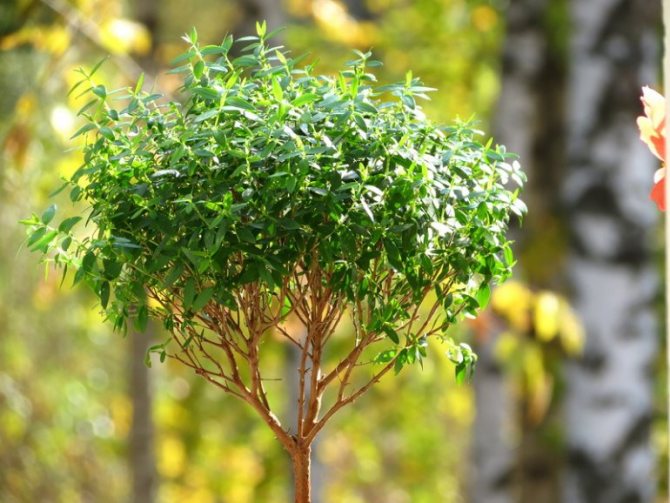

Dull leaves, rolling them
Excessive lighting leads to yellowing of the leaves, the edges of which are curled. This happens if direct sunlight falls on the myrtle, which can cause burns and yellowness of the green mass. In this case, move the flower to another windowsill, where it will be safest for it to be.
Features of growing myrtle
The main feature of myrtle breeding is the need for cold wintering. As a southern dweller, he loves light and high humidity. Myrtle is a flowering plant. For good flowering, it needs pinching. On the other hand, if its crown is actively formed, its ability to bloom may suffer. Therefore, you need to know the basic rules for pruning and decide what you like more - a flowering tree or a plant with a beautifully formed crown.
Another feature of myrtle is its slow growth. For a year, the tree adds only 10-15 cm.
Myrtle is not very whimsical and not difficult to care for. It is enough to provide him with temperature, light and watering conditions.
Growing difficulties
When cultivating myrtle, many growers face various problems.
The stems stretch out, the leaves shrink and turn pale
When the stems are pulled vigorously, the leaves become very small. This indicates a lack of lighting.
Leaves fade, turn yellow, edges curl
If the leaves lose their hue and turn yellow, and their edges curl, this indicates an excessive amount of lighting.
Leaves fall
If the leaves dry up and crumble in winter, you can suspect increased air dryness and temperature. The plant requires cool air and moisture. Also, leaf fall is observed with stagnant water and sunburn.
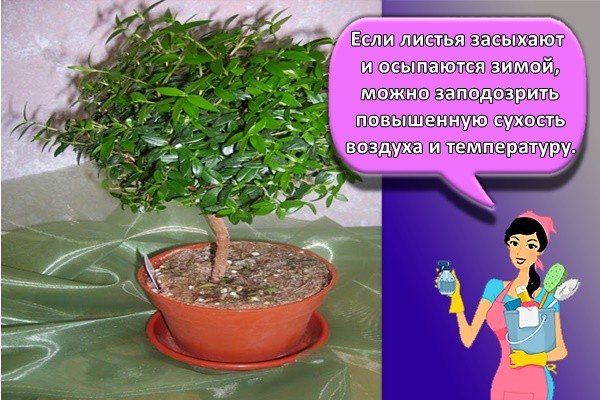

Diseases and pests of myrtle
| Disease or pest | Symptoms | Control measures | Prophylaxis |
| Root rot | The ends of the shoots turn black, the leaves fall off. |
|
|
| Whitefly | The leaves wither and turn yellow, there are green larvae on the underside, and white flies fly around. |
| Inspect the plant regularly to prevent pests from breeding. |
| Spider mite | The leaves turn yellow, crumble, a cobweb is visible on the petioles. | Moisten the air and the plant regularly, the mite reproduces only in dryness. | |
| Aphid | Young shoots and leaves are deformed and die. |
| Examine the myrtle, take action at the first sign of defeat. As a rule, parasites enter the house with new plants. Quarantine them for 2-3 weeks before sharing with other pets. |
| Shield | Brownish, hard plaques on the leaves. Sometimes a sticky coating appears. |
If the leaves have become sticky, it is difficult or impossible to fight the parasite. | |
| Mealybug | White, sticky fluff on the leaves. They turn yellow and die off. |
|
Healing properties
Myrtle products have a number of beneficial properties. They have an astringent effect, heal wounds, and stop bleeding. Also, myrtle relieves inflammation, eliminates tumor formations, produces an antitoxic effect, copes with pain and viral infections. Myrtle is used to fight inflammatory processes in the digestive system.
The plant oil is suitable for outdoor use. It is used to treat viral infections and colds.
It is useful to be near the plant with rhinitis, tonsillitis, sore throat, flu. Myrtle secretes phytoncides, helps to cope with pathogenic bacteria, to increase the overall resistance of the body. For colds, it is useful to chew the leaves of the culture. They strengthen the immune system and help to quickly eliminate the disease. Myrtle essential oil has a sedative and analgesic effect. Therefore, it is used for headaches. Also, the plant is considered a natural antibiotic.
See also
Growing and caring for pelargonium at home for beginners
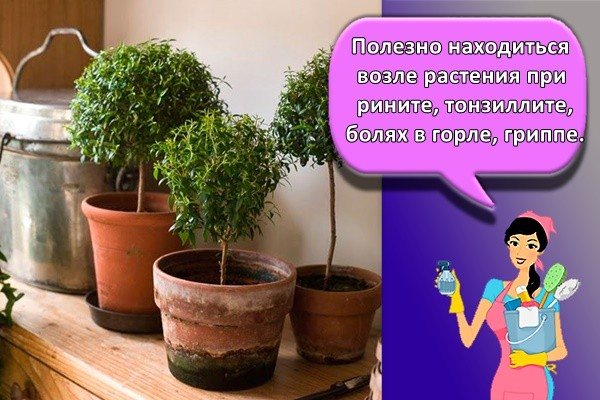

Pruning and pinching
The formation of a bush or tree is carried out in the event that it does not matter whether the myrtle will bloom or not. Drastic pruning inhibits bud formation. Experienced growers recommend that you first form a bush, and then wait for the flowers to appear.
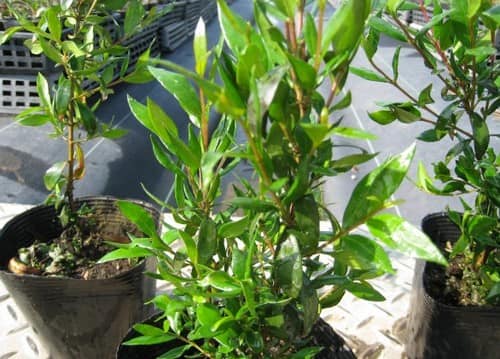

Shoot pruning is carried out at 1/3 of the length. Pinching is most often practiced; it is performed on the third leaves.
To get a "ball", the myrtle should not only pluck mercilessly, but also twist the pot around its axis (for uniform illumination). When growing myrtle from a cutting, immediately consider what shape you want to achieve.
If you prefer a tree in one trunk, pinch a twig at a height of 15-20 cm. It will start branching, the growing shoots can be formed as you like - a ball, a crown tree. Myrtle makes a great bonsai.
Pruning and pinching are carried out during the growing season, that is, during the warm season. In winter, it is better not to touch the flower, since it is at rest.
How to make myrtle leaf tincture?
It's pretty easy to do it yourself. Take a liter jar, put about 100 g of leaves there and pour 500 g of 60-70% alcohol or vodka. For two weeks, you need to infuse the mixture in a dark place. It is advisable to shake the jar daily. Then filter the infusion. For the prevention of diseases, 30 minutes before meals, you need to take 20 drops of infusion 3 times a day.
You can get the benefits of the plant simply by placing it in the room: it will purify the air from various viruses and microbes. It is not recommended to put myrtle in the bedroom. You will love the scent of the tree. Myrtle is ideal for both home and office.
Myrtle is a symbol of a strong, prosperous, friendly family. It will be an excellent gift for newlyweds and already experienced families.
Possible problems
Myrtle in natural conditions has few pests and rarely gets sick. In pot culture, greenhouses and conservatories, despite the fact that it is an essential oil plant, it is annoyed by:
- whitefly;
- mealybug;
- spider mite;
- thrips;
- aphids.
Among the diseases, one should single out the mob (sooty fungus) and a variety of rot that can occur from excessive watering, especially in a poorly drained substrate.
Most problems can be dealt with by placing the wood in the bathroom and treating it with laundry soap. But you need to rinse the myrtle right away, while most other plants should stand for 15-30 minutes.If it stays in the soapy foam for more than 5 minutes, the alkali will simply burn the leaves, and they will fall off. The same will happen if at least a little soap remains on the plant.
Important!
It is also necessary to rinse the myrtle after using chemical remedies.
Most of the other problems are related to landing and grooming errors:
- when the root collar is deepened, the myrtle will be very sore, wither, and if urgent measures are not taken, it will die;
- if the leaves curl or turn black, the tree should be moved away from the light source or sprayed more often;
- myrtle can shed leaves in a draft, from overflow or drying out of the substrate, insufficiently sunny position; high temperature during rest, dry air;
- lack of light leads to the development of long weak shoots on the tree, lack of flowering, the appearance of too small pale leaves.
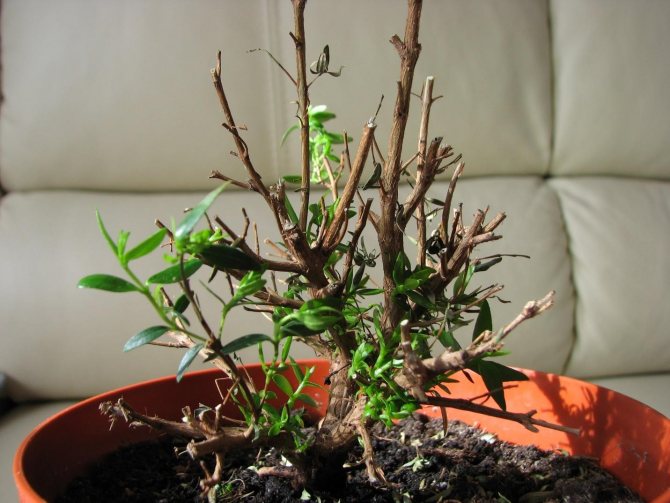

Sick tree
Description and features of the plant
According to various estimates, there are from 40 to 100 varieties of myrtle. In nature, culture reaches 3 meters. Indoor flower usually does not exceed 1 meter. The house plant is a small myrtle tree with a rounded crown and reaches 30-60 centimeters in height.
The plant is characterized by small leathery leaves, which are attached to the branches with short petioles. The culture has elongated leaves with a pointed tip. Flowers are simple or double. They grow one at a time or form a brush. The fruits are presented in the form of berries or nuts.
Which pot to choose for myrtle
Which pot to choose for myrtle? In garden stores, all indoor plants are sold in standard plastic containers. It is not recommended to keep any flower in this container in the future, including myrtle. Therefore, when buying this new copy for your flower garden, you must also purchase a pot for transplanting.


Plant pots
For the development of a strong and healthy tree, a pot with drainage holes and a water tray should be selected for the myrtle. This plant does not tolerate drought, but even with stagnant water, its root system begins to rot.
It is better to choose a flower pot made from natural materials: white and red clay, chamotte, ceramics. Due to their structure, such containers improve the access of oxygen to the soil substrate, prevent waterlogging of the soil and exclude overheating of the earth coma from the sun's rays.
It is also important to choose the right pot size. It is not worth buying a large flowerpot right away. With such a planting, the plant spends all its strength on the formation of the root system.
The aboveground part does not develop in this case. Therefore, the volume of the pot increases gradually, with each transplant by a couple of centimeters. The optimal volume of the pot will be half the volume of the crown.
In a suitable flowerpot, the myrtle tree takes root well, and multiple branches with leaves of a rich color are formed on its crown. The correct myrtle pot makes plant maintenance much easier and prevents the development of diseases.
Planting and breeding
Getting a new myrtic is pretty easy, unless you decide to do it with seeds that germinate very poorly. If you do dare to experiment, keep in mind that the seeds need stratification.
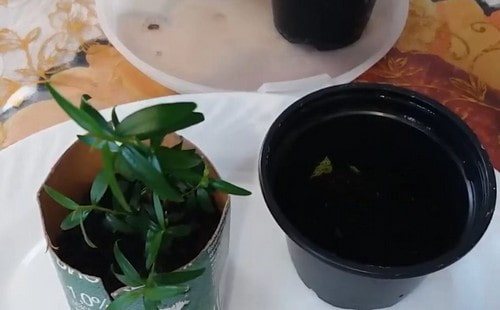

Cuttings, on the other hand, root well - both in the ground and in the water. It is best to take a lignified twig, but you can also take the upper shoot obtained as a result of pruning (about 10 cm high).
Dip the cut in Kornevin, plant it in a glass with soil and put it in the greenhouse. It is done like this: cut off the upper part from a plastic bottle, put a glass with a handle in it, cover with a neck with a twisted lid.
Cuttings root well in a mixture of vermiculite, universal soil and sand, peat tablets. In the latter, within a month, roots appear that are not injured when transplanted into a permanent pot.
Important: to form a standard plant (tree), an apical cutting is taken. If you want to get a bush, intermediate cuttings are suitable for propagation.
Reproduction of chamelacium using cuttings
Chamelacium is propagated using seeds, cuttings and by grafting. The seed method is used extremely rarely, since the seed of this crop has a low germination rate.
To obtain a new plant, wax myrtle is cut. This work is carried out from spring to autumn. For reproduction of chamelacium in an adult bush, the strong tops of shoots 5 - 8 cm long are cut off, after which they are placed in a container with water or a loose substrate consisting of peat and sand. The cuttings are buried 2 cm and covered with a jar or plastic wrap. This is how greenhouse conditions are created for the germination of the root system.
Containers with cuttings are removed in a well-lit place with a temperature of 25 - 27 degrees. The shelter is cleaned daily for ventilation. Roots appear in such conditions in 1 - 1.5 months. It so happens that the root system of the cuttings is not formed at all. For this reason, it is recommended to root several shoots at the same time, and then, you can get at least one rooted copy.
Why does myrtle shed leaves
When the heating is on and the air is dry, the myrtle begins to shed its leaves. In nature, it hibernates in the open field, where it is cool and rather damp. Try to bring the conditions closer to natural - place it where it is cool. Protect from the battery with a foam shield.
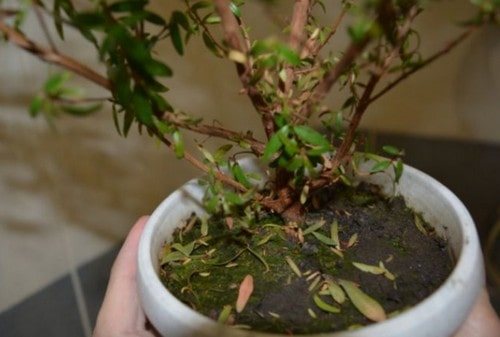

If the myrtle leaves a little during the winter, this is normal. Even if the tree has completely shed its leaves, do not rush to throw it away. Wait until spring, water occasionally.
In most cases, the plant wakes up and new leaves appear on it. If this did not happen, unfortunately, we have to admit that the flower died.
Signs and superstitions
Since ancient times, the Myrtle tree has been endowed with magical properties and has been closely associated with many religions. For example, this is what Adam and Eve took with them when they left the Garden of Eden. Later, Myrtle served as their amulet.
Nowadays, many people also believe in the signs associated with the Myrtle tree. The presence of myrtle in the home will lead to a welcoming environment in the family. A wreath of Myrtle branches will have a positive effect on harmony in relationships, and if you weave roses into it, it will strengthen the bonds of marriage. That is why, to this day, the Myrtle tree is an excellent wedding gift.


